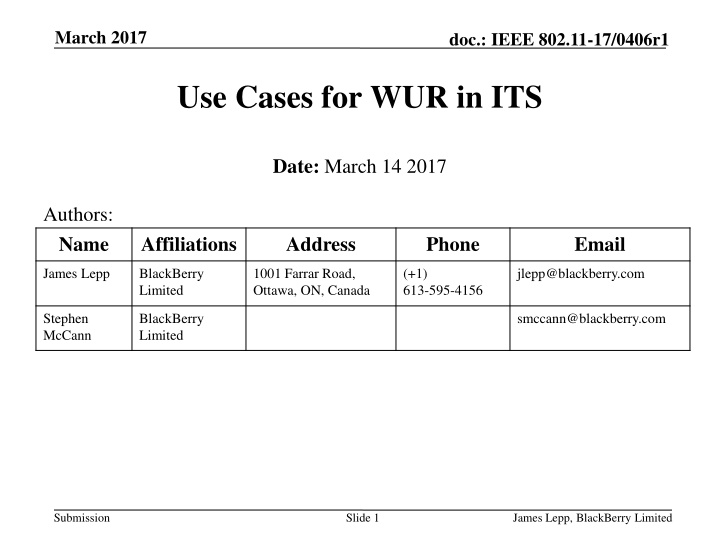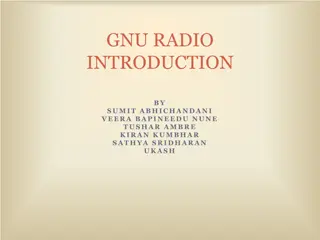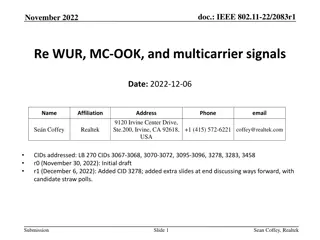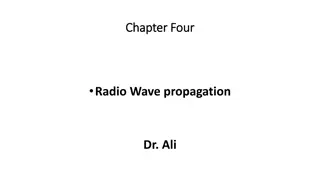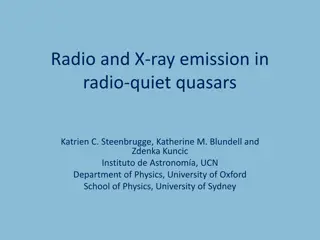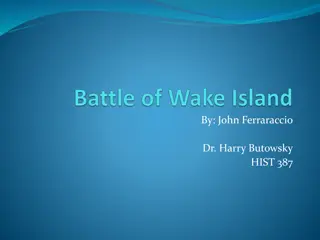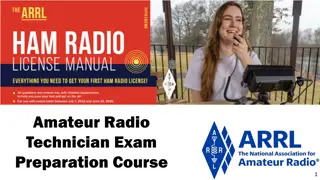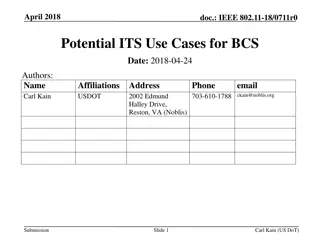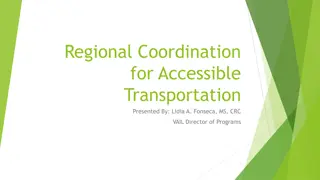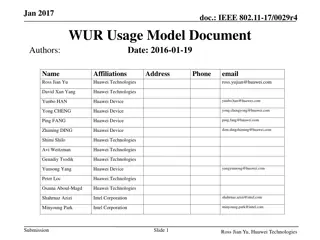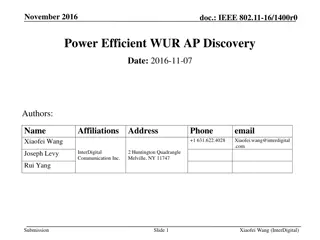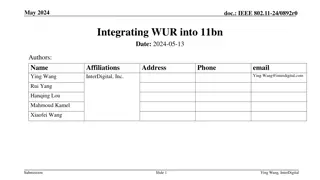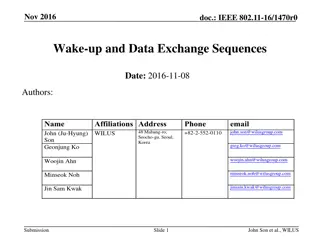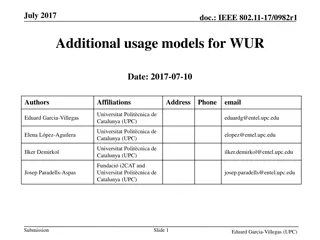Usage Models for IEEE 802.11 Wake-up Radio in Intelligent Transportation Systems
This document explores the usage models for implementing IEEE 802.11 Wake-up Radio (WUR) in Intelligent Transportation Systems (ITS). It discusses scenarios involving Vehicle-to-Pedestrian (V2P) communications, power-saving mechanisms, and low-latency requirements.
Download Presentation

Please find below an Image/Link to download the presentation.
The content on the website is provided AS IS for your information and personal use only. It may not be sold, licensed, or shared on other websites without obtaining consent from the author.If you encounter any issues during the download, it is possible that the publisher has removed the file from their server.
You are allowed to download the files provided on this website for personal or commercial use, subject to the condition that they are used lawfully. All files are the property of their respective owners.
The content on the website is provided AS IS for your information and personal use only. It may not be sold, licensed, or shared on other websites without obtaining consent from the author.
E N D
Presentation Transcript
March 2017 doc.: IEEE 802.11-17/0406r1 Use Cases for WUR in ITS Date: March 14 2017 Authors: Name Affiliations Address Phone Email James Lepp BlackBerry Limited 1001 Farrar Road, Ottawa, ON, Canada (+1) 613-595-4156 jlepp@blackberry.com Stephen McCann BlackBerry Limited smccann@blackberry.com Submission Slide 1 James Lepp, BlackBerry Limited
March 2017 doc.: IEEE 802.11-17/0406r1 Background on 802.11ba (WUR) 802.11ba Wake-up Radio (WUR) is a low power mechanism to enable power saving in 802.11 stations. In January 2017 it was decided to compile a Usage Model Document for 802.11ba. This presentation contains Usage Models for the 802.11ba task group to consider when designing the WUR protocol. Submission Slide 2 James Lepp, BlackBerry Limited ..
March 2017 doc.: IEEE 802.11-17/0406r1 Background on 802.11 ITS systems 802.11-OCB (developed in 802.11p TG) is used as the basis of Intelligent Transportation Systems. Outside the context of a BSS devices transmit 802.11 frames between vehicle onboard units (OBUs) and infrastructure roadside units (RSUs). Current 802.11-based ITS systems use a significant amount of energy to operate. To enable a third class of system for pedestrians and cyclists, as a group called vulnerable road users (VRUs), mechanisms to enable power saving are desired. Submission Slide 3 James Lepp, BlackBerry Limited
March 2017 doc.: IEEE 802.11-17/0406r1 Use Case 1: Wake Up Vehicle-to-Pedestrian (V2P) Radio Scenario Pedestrian carrying portable device with V2P capability. To conserve power, the V2P mode isn t always operating. Roadside infrastructure such as an intersection or an oncoming vehicle sends WUR wake-up trigger frame. Pedestrian device wakes up and operates 802.11-OCB based V2P Wakeup operation ITS infrastructure sends WUR wake-up trigger frame Pedestrian device wakes up and operates 802.11-OCB Requirements Low power and low latency Submission Slide 4 James Lepp, BlackBerry Limited
July 2015 doc.: IEEE 802.11-17/0406r1 Usage Model 1: Wake Up Vehicle-to-Pedestrian (V2P) Radio Environment Vehicles, Road Infrastructure and Pedestrian/Cyclist carried device. Applications Trigger other devices to turn on (or off) automotive safety radio operation Traffic Conditions 802.11-OCB traffic, 802.11 traffic depending on channels used Use Case Pedestrian/cyclist approaches dangerous intersection or moving vehicle Infrastructure or vehicle sends WUR wakeup frame Pedestrian/cyclist carried device turns on automotive safety radio operation (802.11-OCB) Challenges and requirements Operation outside the context of a BSS Addressing as broadcast/unicast If used in 5.9Ghz band, coexistence, channel choice Submission Slide 5 James Lepp, BlackBerry Limited
March 2017 doc.: IEEE 802.11-17/0406r1 Use Case 2: WUR Vehicle-to- Pedestrian (V2P) Scenario Pedestrian carrying portable device. Roadside infrastructure such as an intersection or an oncoming vehicle sends WUR wake-up trigger frame containing ITS information. Wakeup operation ITS infrastructure sends WUR wake-up trigger frame Pedestrian device receives and decodes ITS related information in the WUR wake-up trigger frame Requirements Low power and low latency WUR trigger frame contains small amount of data Submission Slide 6 James Lepp, BlackBerry Limited
July 2015 doc.: IEEE 802.11-17/0406r1 Usage Model 2: WUR Vehicle-to- Pedestrian (V2P) Environment Vehicles, Road Infrastructure and Pedestrian/Cyclist carried device. Applications Transmit ITS related information to very low power devices Traffic Conditions 802.11-OCB traffic, 802.11 traffic depending on channels used Use Case Vehicle approaches pedestrian/cyclist Vehicle transmits WUR wakeup frame Pedestrian/cyclist receives ITS related information Challenges and requirements Operation outside the context of a BSS Addressing as broadcast/unicast If used in 5.9Ghz band, coexistence, channel choice How much data to encode in WUR frame (10B, 100B, 1kB) Submission Slide 7 James Lepp, BlackBerry Limited
March 2017 doc.: IEEE 802.11-17/0406r1 Additional thoughts Previous power-saving mechanisms in 802.11 were created with expense of high latency. The combination of low power and low latency means WUR is capable of is applicable to more than just IoT. Can WUR be transmitted in the DSRC channels 172- 178 (aka 5.9 GHz band) and used to enhance V2X communications. Submission Slide 8 James Lepp, BlackBerry Limited
March 2017 doc.: IEEE 802.11-17/0406r1 Straw Poll Should the 802.11ba task group add the above usage models to WUR? Yes No Abstain Submission Slide 9 James Lepp, BlackBerry Limited
